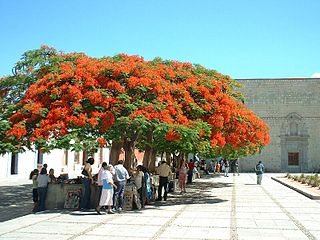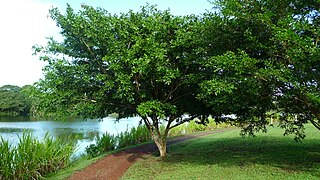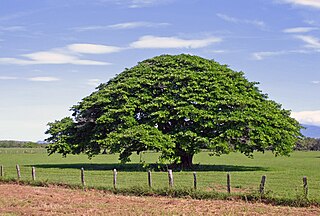
The Mimosoideae are a traditional subfamily of trees, herbs, lianas, and shrubs in the pea family (Fabaceae) that mostly grow in tropical and subtropical climates. They are typically characterized by having radially symmetric flowers, with petals that are twice divided (valvate) in bud and with numerous showy, prominent stamens.

Caesalpinioideae is a botanical name at the rank of subfamily, placed in the large family Fabaceae or Leguminosae. Its name is formed from the generic name Caesalpinia. It is known also as the peacock flower subfamily. The Caesalpinioideae are mainly trees distributed in the moist tropics, but include such temperate species as the honeylocust and Kentucky coffeetree. It has the following clade-based definition:
The most inclusive crown clade containing Arcoa gonavensisUrb. and Mimosa pudicaL., but not Bobgunnia fistuloides(Harms) J. H. Kirkbr. & Wiersema, Duparquetia orchidaceaBaill., or Poeppigia proceraC.Presl

Bauhinia is a large genus of flowering plants in the subfamily Cercidoideae and tribe Bauhinieae, in the large flowering plant family Fabaceae, with a pantropical distribution. The genus was named after the Bauhin brothers Gaspard and Johann, Swiss-French botanists.

Cassia is a genus of flowering plants in the legume family, Fabaceae, and the subfamily Caesalpinioideae. Species are known commonly as cassias. The genus includes 37 species and has a pantropical distribution. Species of the genera Senna and Chamaecrista were previously included in Cassia. Cassia now generally includes the largest species of the legume subtribe Cassiinae, usually mid-sized to tall trees.

Peltogyne, commonly known as purpleheart, violet wood, amaranth and other local names is a genus of 23 species of flowering plants in the family Fabaceae; native to tropical rainforests of Central and South America; from Guerrero, Mexico, through Central America, and as far as south-eastern Brazil.

The subfamily Detarioideae is one of the subdivisions of the plant family Fabaceae (legumes). This subfamily includes many tropical trees, some of which are used for timber or have ecological importance. The subfamily consists of 84 genera, most of which are native to Africa and Asia. Pride of Burma and tamarind are two of the most notable species in Detarioideae. It has the following clade-based definition:
The most inclusive crown clade containing Goniorrhachis marginataTaub. and Aphanocalyx cynometroidesOliv., but not Cercis canadensisL., Duparquetia orchidaceaBaill., or Bobgunnia fistuloides(Harms) J. H. Kirkbr. & Wiersema.

Andira is a genus of flowering plants in the legume family, Fabaceae. It is distributed in the tropical Americas, except for A. inermis, which also occurs in Africa. It was formerly assigned to the tribe Dalbergieae, but molecular phylogenetic studies in 2012 and 2013 placed it in a unique clade within subfamily Faboideae named the Andira clade.

Copaifera is a genus of tropical plants in the legume family Fabaceae. It includes 40 species native to the tropical Americas, west and central tropical Africa, and Borneo.

Dimorphandra is a genus of legume in the family Fabaceae, subfamily Caesalpinioideae. It includes 26 species native to northern South America, ranging from Colombia and Venezuela to Bolivia, Paraguay, and southeastern Brazil.

Macrosamanea is a genus of flowering plant in the legume family, Fabaceae. It includes 11 species of trees and shrubs native to northern South America. The genus is most diverse and numerous in the Amazon Basin, extending into the Orinoco basin and the Guianas. Typical habitat is tropical rain forest, mostly riparian and seasonally-flooded. Two species are native to seasonally-inundated wooded grassland (savanna) on sandy soils. The genus belongs to the mimosoid clade of the subfamily Caesalpinioideae.
Vouacapoua is a genus of legume in the family Fabaceae, subfamily Caesalpinioideae. It includes three species of trees native to northern South America, ranging from the Guianas to northern and northeastern Brazil. They grow in terre firme Amazonian rain forest.

Zygia is a genus of flowering plants in the family Fabaceae. It includes 60 species of tres and shrubs native to the tropical Americas, from Southern Mexico and Cuba to northern Argentina. Typical habitats are tropical forest and coastal zones, generally below 900 meters elevation with a few species extending up to 2800 meters. It belongs to the mimosoid clade of the subfamily Caesalpinioideae.

Enterolobium is a genus of 12 species of flowering plants in the family Fabaceae, native to tropical and warm-temperate regions of the Americas. They are medium-sized to large trees.

Recordoxylon is a genus of flowering plants in the legume family, Fabaceae. It includes three species of trees native to the tropical Amazon rainforest of northern South America, and the species' range includes northern Brazil, Colombia, French Guiana, Guyana, and Venezuela. Habitats include non-flooded rain forest on terra firme, seasonally-flooded riverine forest (várzea), and montane forest.

Hymenolobium is a genus of flowering plants in the legume family, Fabaceae. It includes 14 species of trees native to Central America and northern South America, ranging from Honduras to Bolivia and southeastern Brazil. Most species are native to Brazil, the Guianas, and Venezuela, with one extending into Peru, another into Ecuador, and one native to Central America. Trees are typically very tall and emergent in tropical humid lowland rain forest.
Vataireopsis is a genus of flowering plants in the legume family, Fabaceae. It includes four species of small to emergent trees, native to northern South America, ranging from Colombia, Venezuela, and the Guianas to Bolivia and southern Brazil. They grow in tropical lowland rain forest, in both the Amazon and Atlantic Forest.

The tribe Dalbergieae is an early-branching clade within the flowering plant subfamily Faboideae. Within that subfamily, it belongs to an unranked clade called the dalbergioids. It was recently revised to include many genera formerly placed in tribes Adesmieae and Aeschynomeneae and to be included in a monophyletic group informally known as the dalbergioids sensu lato. The members of this tribe have a distinctive root nodule morphology, often referred to as an "aeschynomenoid" or "dalbergioid" nodule.

Dialypetalantheae, synonym Condamineeae, is a tribe of flowering plants in the family Rubiaceae and contains about 305 species in 31 genera. Most genera are found in Central and Southern Tropical America, but a few occur in Southeast Asia.

The subfamily Dialioideae is one of the subdivisions of the plant family Fabaceae (legumes). This subfamily includes many tropical trees and shrubs. The subfamily consists of 17 genera, which are widespread throughout the tropics. It has the following clade-based definition:
The most inclusive crown clade containing Poeppigia proceraC.Presland Dialium guianense(Aubl.) Sandwith, but not Cercis canadensisL., Duparquetia orchidaceaBaill., or Bobgunnia fistuloides(Harms) J. H. Kirkbr. & Wiersema
Naiadendron duckeanum is a species of flowering plant in the legume family, Fabaceae. It is a tree endemic to northern Brazil, where it grows in moist tropical lowland forest. It is the sole species in genus Naiadendron.

















